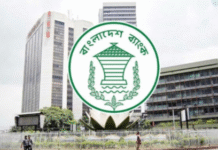
The favourable US dollar-taka exchange rate has lent a helping hand to apparel exporters in the outgoing calendar year, cushioning the fallout from the uncertain political climate in the Western world.
In the first 11 months of 2017, Bangladesh exported garment items worth $26.40 billion, up 1.38 percent year-on-year, according to data from the Export Promotion Bureau.
At the start of the year, the greenback traded between Tk 78 and Tk 79 and during the course of the year it crawled up. On December 20, it traded at Tk 83.20.
“The current exchange rate is favourable for exporters. We should handle the exchange rate softly,” said Ahsan H Mansur, executive director of the Policy Research Institute of Bangladesh. He went on to suggest that the dollar can be allowed to appreciate to up to Tk 85.

If it goes past the Tk 85-mark, it will be bad for the balance of payment and macroeconomic stability as imports would become costlier.
However, exporters want further devaluation of the local currency.
“The exchange rate has only started becoming export-friendly,” said Faruque Hassan, managing director of Giant Apparels, a leading garment exporter.
The local currency should be devalued further against the dollar to compensate for the rising cost of production such that exporters can continue to be competitive on the global stage. At least 10 percent devaluation of the currency is fine for the sector as garment exporters have faced low exchange rate over the last five years, he added.
“The exchange rate is still not up to the mark when compared with our competing countries like India and Turkey,” said Abdus Salam Murshedy, managing director of Envoy Group, another major garment exporter.
Apart from the favourable exchange rate, the rising shipment of value-added items, brighter image of Bangladesh’s garment sector after remediation works, relative political calm and automation of production also helped prop up garment exports in 2017.
“The outgoing year was good for us,” Murshedy said, adding that the absence of any major untoward incident like labour or political unrest was a boon for the apparel exporters.
Garment exporters are cautiously optimistic about the new year as the country’s apparel sector is on a strong footing following the thumbs-up from the Accord and Alliance, the two foreign factory inspection agencies.
Nearly 80 percent of the remediation works to fix electrical, fire and structural flaws have been completed.
“After the inspection and remediation, our capacity has been internationally recognised. We are hoping for better business opportunities after this,” Murshedy said.
Besides, the economies of major export destinations are rebounding gradually from the shocks of Brexit and general elections in many EU countries, he said.
Siddiqur Rahman, president of the Bangladesh Garment Manufacturers and Exporters Association, forecasts that export receipts will be about 10 percent higher next year.
“Ideally, it should be more than 15 percent given the current capacity of the factories.”
However, for achieving higher export growth the government should give the highest priority to addressing issues like congestions in the premier port in Chittagong, Hazrat Shahjalal International Airport and Benapole land port to shorten the lead-time, he said.
Adequate power and energy should be ensured and the infrastructures, especially the Dhaka-Chittagong highway, must be enhanced.
The exporters see the political instability as a major challenge in the new year as the general election is due to be held at the end of next year or in early 2019.
“We expect there will not be any political instability — we hope the political leaders will give priority to a stable export growth for the sake of the country.”
A good number of new factories will come into operation next year as entrepreneurs are putting in money in the sector targeting the shifted work orders from China, the largest garment exporter worldwide.
Source: The Daily Star.









